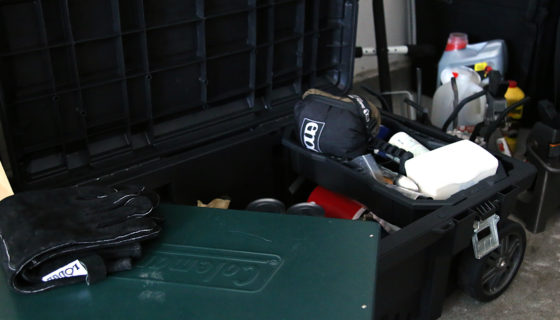Small Team Tactics: Simple and Light = Freedom, Agility and Mobility
Small Team Tactics: Simple and Light = Freedom, Agility and Mobility
I believe in being nimble. Being small and light allows you to move more fluently and act faster. Being light also allows you to be more efficient.
You don’t need a large team to be successful, you simply need the right team. The right people can perform at a higher level and be responsible for multiple tasks. Having a small team means that it can adapt faster, which also means that the momentum can be stopped if necessary. For example, if a 180 degree plan B needs to be executed, then the team dynamic won’t be affected.
Big teams committed to a plan are harder at adapting. Their weight alone makes this almost impossible. Think about SOF teams, which are small and agile. There’s a reason for that.
SOF teams worldwide tend to be small, autonomous and self-reliant. Because of this, they can operate at much higher level. Each team member provides valuable insight into his or her area of expertise. A good team needs to be both small and smart. The mindset of the team also needs to be geared toward this and have an adaptive mindset.
Rule 9: “A simple plan with a flexible blueprint will survive real world contact far better than a complex and rule-bound plan.”
This should be applied in all levels, from planning to execution. Every plan should be simple enough to allow a quick change on the fly, based on the environment and what’s on the field. No plan survives the first contact with the enemy and a good team needs this flexibility in order to change. If your team stays small and flexible, it will also reduce the resistance to change and adapt.
A small team comprised of the right people can communicate better, act & react smoothly and provide cleaner ideas.
Leveraging Team Strength
The first thing to understand are the individuals that comprise your team. It is a team, but without its members, a team is not much of anything.
Each member in the team has his or her own strengths. It’s the job of each and every team member to know the rest of the teammates and to know who can do what and under what situation. It’s also crucial to know how each of the members perform when it counts; under stress, without sleep or when time is really tight.
People tend to act differently when they’re in a team environment than when they work solo. Can they handle it? Can they take criticism? Can they give it?
Each member has a specific strength. One member might have a better touch when dealing with people, while another might have infinite patience and could sit in front of a list of hex numbers for hours while reverse engineering a piece of software. Another member may be mechanically inclined and able to fix anything, regardless of what it is. These are just a few examples.
While these strengths often derive from previous training and experiences, a lot of times this is just natural talent. Discovering these talents during the initial interview with a member or while on a project is critical for the team to evolve and become better. Sure, junior guys benefit a lot from being paired with a senior member on specific projects, however sometimes the opposite is true. A junior guy can bring a lot to the table and senior members need to be comfortable working under them. It keeps the team constantly learning and staying fresh.
To to fully accomplish this, you have to really know your teammates. One way of doing this is to put the person that might be best suited to lead a particular project or operation, in charge of planning. Pay attention to the other members, can anyone think differently on that specific subject matter? Maybe there’s someone that you thought had no knowledge of this specific subject but here he is, taking the expert for a ride. Maybe his talent resides in poking holes in a plan, he can then become the contingency guy.
You’d be surprised with the results you can get with these exercises, not to mention the team building that takes place. Experiment with this idea and have your team assess itself.
Adapt
Adaptation is the name of the game, what worked once will not necessarily work twice. Essentially, you have to methodically discard the plans, possible solutions and schemas that would likely fail based on the analysis of the problem at hand. This works particularly well in small teams, when the plan has to be perfect. There aren’t many resources on a small team.
After collecting as much intelligence as possible and after you’ve performed recon and observed your target, either physical or digital, you then can red team your own solutions. Use proactive failure analysis to discard the solutions that might fail based on the intelligence you’ve just collected. You then adapt the remaining solutions to this same intelligence and prepare the primary, alternate, contingency and emergency plans.
This same technique is used by attackers. They adapt based on an analysis of their failed attacks and factor this into future attack plans.
When in Doubt, Develop the Situation
“Developing the situation is the common-sense approach to dealing with complexity. Both a method and a mind-set, it uses time and our minds to actively build context, so that we can recognize patterns, discover options, and master the future as it unfolds in front of us” – Pete Blaber, The Mission, The Men and Me, 2008
In any new situation, common sense and/or the Red Team Mindset should be used. It’s important to recognize patterns, discover possible alternatives and options, as well as prepare different solutions based on the analysis.
Developing the situation means innovation and new approaches. Skip the defaults look for new options. A team can truly come together through different ideas based on the intel from the ground or past experience.
The best information is real-time situational awareness based on what is actually happening on the ground right now. In order to accomplish this, you have to be open to new ideas. Once information is flowing from the field (by a team member or by direct collection,) you can begin to get a context of what’s going on. This collection of intelligence allows you to put the pieces together and plan accordingly.
It’s important that each team member have a say in the planning phase. This is key on small teams. Each member has his/her own interpretation of the information and these different views can provide the next level in developing the situation. Hear what each member has to say about the developing issues and have them state a plan of action and poke holes in your own plan. Develop the situation.
A Parting Thought
Problems will arise on a small team. There’s no way around it. Keep in mind that sometimes these problems have a reason. Take a step back, analyze this and continue forward.
“If you have the same problem for a long time, maybe it’s not a problem—it’s a fact” – Yitzhak Rabin
Editor-in-Chief’s Note: U. Fridman is a senior information security consultant that specializes in detection of information security threats and response to security incidents. His background includes extensive experience in red team activities and management, information warfare, counter cyber-terrorism, industrial espionage, forensics analysis and other security services.
Title image “Cast of a Few, Courage of a Nation” [CIA]












Discussion